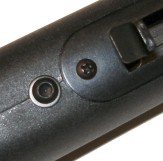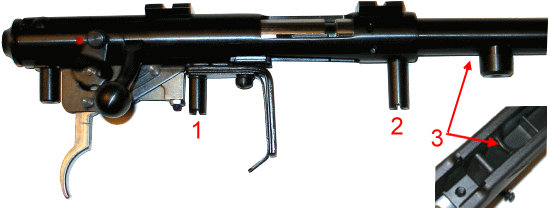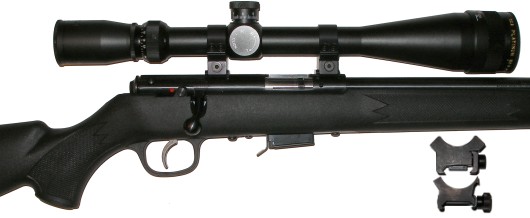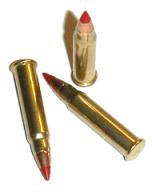 Many years ago, my wife and I were called into the school our children were attending, regarding a son’s behavior in his first grade classroom. He was described as having a short span of attention, easily bored by inactivity and unable to sit quietly for extended periods of time. I suggested they had just described children…no, better still, they had just described me. Kids are active and sometimes difficult to keep entertained, so the best way to develop a child’s interest in firearms is to make sure they are always having fun. Yes, punching holes in targets can be fun, but blowing up water balloons and plastic jugs filled with water is much more…funner.
Many years ago, my wife and I were called into the school our children were attending, regarding a son’s behavior in his first grade classroom. He was described as having a short span of attention, easily bored by inactivity and unable to sit quietly for extended periods of time. I suggested they had just described children…no, better still, they had just described me. Kids are active and sometimes difficult to keep entertained, so the best way to develop a child’s interest in firearms is to make sure they are always having fun. Yes, punching holes in targets can be fun, but blowing up water balloons and plastic jugs filled with water is much more…funner.
The selection of a gun for small shooters can be challenging. Actually, just trying to carry on a conversation with the little space aliens can sometimes be challenging. A diminutive single shot bolt action youth rifle will eventually gaze over the eyes of even the most enthusiastic child. A semi-auto rim fire will be lit up in a blaze of rapid fire at the expense of a clear sight picture, concentration and trigger squeeze. Safety is vital, and learning and following the rules is not an option to trainer or trainee, but mandatory loading and cycling of a single shot bolt action may be deemed cruel and unusual punishment to a young shooter. We felt we would keep our eight year old grandson interested in recreational shooting by at least making sure he has a gun to shoot that fits his frame, a gun that is a repeater, and a bolt action for more controlled shooting. After my wife and I looked at and measured a number of compact firearms, we elected to go with a Savage Model 93 chambered for the 17 HornadyMagnum Rim Fire, specifically the Model 93R17-F.
The Model 93 has a 5 round magazine capacity, 20.75″ barrel, and is 39.5″ in overall length. While the pull is a not so short 13.25″, the reach from trigger to comb is only 2″ and the comb is low so a young shooter can comfortably rest their face against the stock. The gun weighs only 5 lbs and feels a little forearm heavy, but the center of gravity is actually right where the barrel meets the receiver, or right at the action fastener just forward of the magazine. The arm extension required to reach a comfortable spot on the forearm is just at 20″. If you lay the gun down next to a Winchester Model 70 Compact centerfire rifle, they are almost identical is size and proportion. The Savage’s stock is a neatly finished black synthetic with swivel studs, the metal parts are a luster finished blue. There are, of course, numerous other versions of the Model 93 with wood stocks, heavy barrels and stainless hardware and barreled action. All Model 93’s, regardless the version, comes with Weaver type scope bases and without any form of metallic sight, so if you want to shoot this gun, you’re going to have to buy a scope, or a package model that includes a scope.
 If what I have described in the Model 93 is more than required or too large in scale, Savage does make a smaller rim fire. By comparison, the Model 93 dwarfs, or little peoples, the Model CUB – Mini Youth, above. We felt the 3.3 lb 16″ barrel bolt action single shot was too much of a shooting compromise for our circumstances and, even if useful in the short term, within 6 months it would have been outgrown. There are a number of rifles similar to the CUB on the market, such as the Henry Mini Bolt and Marlin’s Little Buckaroo.
If what I have described in the Model 93 is more than required or too large in scale, Savage does make a smaller rim fire. By comparison, the Model 93 dwarfs, or little peoples, the Model CUB – Mini Youth, above. We felt the 3.3 lb 16″ barrel bolt action single shot was too much of a shooting compromise for our circumstances and, even if useful in the short term, within 6 months it would have been outgrown. There are a number of rifles similar to the CUB on the market, such as the Henry Mini Bolt and Marlin’s Little Buckaroo.
A Few Details….
New shipments of the Model 93 include the Savage AccuTrigger™. The AccuTrigger™, through adjustable spring resistance and the actuation of a sear release lever, can be safely adjusted by the gun’s owner. You can see the sear safety release protruding through the trigger in the picture of the CUB just above. The release mechanism prevents accidental discharge by a jolt to the firearm when the trigger pull is adjusted to very light settings. Again, the AccuTrigger™ was not necessary for our purpose. We were able to locate a new gun, in stock without the AccuTrigger™, which had an out of the box 4.25 lb pull. I think this is about as low as we wanted to go for the purpose of teaching controlled trigger squeeze.
 I believe Savage could have taken a page from Winchester’s approach to trigger shape. The Winchester trigger is curved far aft, thereby shortening the pull for a young shooter without altering the stock. The difference is over .500″. Not as obvious, perhaps, but the shorter Winchester cocking mechanism allows the bolt handle to be positioned farther back toward the shooter, again within easier reach of the young shooter. The Savage bolt cocks on open, the safety can be actuated after the bolt is closed .
I believe Savage could have taken a page from Winchester’s approach to trigger shape. The Winchester trigger is curved far aft, thereby shortening the pull for a young shooter without altering the stock. The difference is over .500″. Not as obvious, perhaps, but the shorter Winchester cocking mechanism allows the bolt handle to be positioned farther back toward the shooter, again within easier reach of the young shooter. The Savage bolt cocks on open, the safety can be actuated after the bolt is closed .

I know there us nothing I like better than mixed fastener types on a firearm. This way, when I reach into my pocket and discover I don’t have a Torx driver, I can look doubly dopey when I discover I am also not carrying a Phillips. Whatever happened to those war time lessons where we learned we should only need a cartridge rim and a bullet tip to disassembled a firearm and if you wanted to open canned rations you just shot the damn thing ? I do not know the reason Savage went with the combo hardware platter, but I assume I would find cost at the top of the list. However why the Allen Head fasteners ? Guns of this type don’t need graded hardware for 35 in/lbs or so of torque used to secure the action to the stock, so I can’t see the need for these specialized fasteners and they are an invitation to over-torque.
Lifting the barrel and action out you find a nicely and precisely fitting stock. The barrel floats to about 1″ forward of the receiver where it is lightly supported by a curved pressure rib that is a part of the molded stock.

Probably a better view of how things are put together. Despite what looks like a lot of securing points, the stock is held snuggly in place by only two screws, points one and two. Two Allen head screws pass through the bare plastic stock and into the metal bosses, or stand offs, extending from the action. The aft screw is prevented from digging into the stock with a simple flat washer aft and surface of the magazine plate forward. #3 shows the placement of the barrel supporting rib embedded in the forearm. The steel threaded lug under the barrel forward of point 3 is pretty much for decoration, on this specific model, as it is not utilized. The two screws and stock support are more than sufficient. As a note of assurance as to how well the action is sandwiched into the stock, one of my all too few hairs abandoned its post and became wedged between the stock and action. It could not be liberated unless both screws 1 & 2 were loosened several threads.
If you’re going to mount a scope….


The 17 HMR is a flat shooting cartridge with lots of zip still left well beyond a hundred yards. When my Marlin 17VS was to be scoped, I went ahead and put on a BSA Platinum 8-32 x 44mm scope with a Mil Dot Reticle and never regretted the decision. The gun performance up to this scope and it is fun making dime size holes at 100 yards with a gun with no recoil and not much noise. Because the Savage is for a young shooter, I wanted something with more eye relief and also a little less weight, so I ordered another target scope only with lesser magnification; 3-12x40mm. In the interim I moved the BSA from the Marlin over to the Savage so I could wrap up the article without delay. Virtually any type of Weaver ring will work with the Savage supplied bases. A .030″ high base would work fine with a 40mm objective, a .050″ was necessary to clear the 44mm, but both are common sizes and readily available.
Performance and a couple of issues…
While the rifle shot very well, it did not have the consistency of the Marlin 17 with its heavy 22″ barrel and stabile laminated stock, or 8 1/2 lb heft. Still, grouping under 1″ – 1 1/4″ and sometimes under 1/2″ at 50 yards, the Savage shot just fine for me. I didn’t bother with 100 yard groups as there was too much of a gusting wind to make a fair assessment, but I will cover that issue when the new scope arrives. The gun handled all of the ammunition types I had on hand: CCI 17-Gr. TNT and 20 grain Gamepoint, as well as Hornady 17 grain V-Max and 20-grain XTP. The Gamepoint and XTP loads seemed to perform the best. The Savage, like the Marlin, works best with a clean bore, unlike my 22 RF guns that get cleaned about once every decade.
The gun is an excellent value. I picked this one up at a discount retailer for under $175, the MSRP is $219. Fancier version that look a lot like the Marlin VS carry an MSRP of $353. I assume Savage is going head to head with Marlin with these 17 HMR models as there is so little obvious difference between the two brands. I think Marlin did the right thing by putting metallic sights in the lighter weight versions, accepting that people like to plink with rim fire rifles and sometimes that does not include the use of a scope. This is the only place I would ding the Savage Model 93R17. I’d rather pay $10 more and get open sights. This way, I could have gotten the grandson checked out with open sights and gradually moved him over to a scope. That said, it is good to see Savage, like a handful of other brands, pushing out a lot of new models and at least attempting to innovate for the benefit of their customers.
Thanks,
Joe

Email Notification